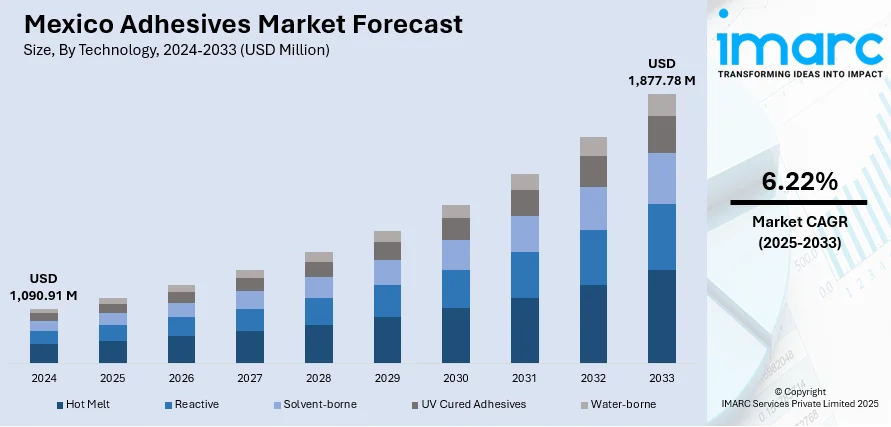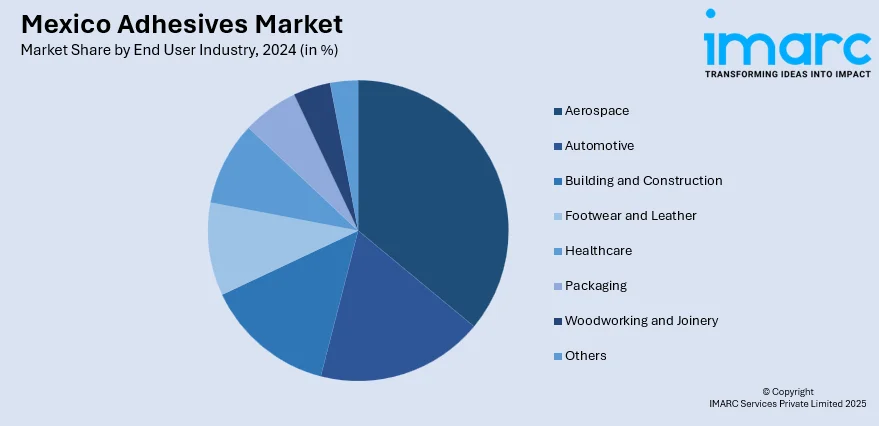
Mexico Adhesives Market Size, Share, Trends and Forecast by Technology, Resin, End User Industry, and Region, 2025-2033
Mexico Adhesives Market Overview:
The Mexico adhesives market size reached USD 1,090.91 Million in 2024. Looking forward, IMARC Group expects the market to reach USD 1,877.78 Million by 2033, exhibiting a growth rate (CAGR) of 6.22% during 2025-2033. At present, increasing electric vehicle (EV) production is driving the demand for adhesives that can handle thermal management and battery assembly. Besides this, the growing user preferences for efficient electronic items, which are encouraging manufacturers to develop high-performance solutions, are contributing to the expansion of the Mexico adhesives market share.
|
Report Attribute
|
Key Statistics
|
|---|---|
|
Base Year
|
2024 |
|
Forecast Years
|
2025-2033
|
|
Historical Years
|
2019-2024
|
| Market Size in 2024 | USD 1,090.91 Million |
| Market Forecast in 2033 | USD 1,877.78 Million |
| Market Growth Rate 2025-2033 | 6.22% |
Mexico Adhesives Market Analysis:
- Major Drivers: Rising vehicle production fueled by Mexico's status as an automotive manufacturing center, escalating demand for electronic devices that need high-performance adhesives bonding solutions, growing packaging industry requirements, increased construction activities aided by infrastructure development, and enhanced usage of environment-friendly adhesive formulations across various industrial segments.
- Key Market Trends: Transition to bio-based and sustainable adhesives formulations compliant with environmental regulations, rising use of UV-cured and reactive adhesives in precision applications, surging demand for structural adhesives in automobile lightweighting programs, enhanced usage of smart adhesives that possess temperature and humidity sensing properties.
- Market Challenges: Fluctuations in raw material price impacting production, strict environmental laws necessitating investment for compliance, high level of competition from long-established international players, limited access to specialized technical skills, and disruption of supply chain affecting consistent material supply and production timeframes.
- Market Opportunities: Growing renewable energy industry generating demand for specialty adhesives, increasing e-commerce boosting packaging adhesive demand, rising foreign direct investment in manufacturing plants, development of sophisticated medical adhesives for healthcare use, and increasing demand for high-performance automotive adhesives.
Mexico Adhesives Market Trends:
Sustainable and Bio-Based Adhesive Solutions
Mexico adhesives market outlook indicates robust growth in high-performance structural adhesives to be used in lightweighting applications in various industries. Automotive companies are increasingly substituting old-fashioned mechanical fasteners with new-generation structural adhesives to trim the weight of vehicles and lower fuel consumption. These adhesives provide higher strength-to-weight ratios while delivering flexibility in design and production efficiency. The aerospace sector is also embracing these solutions for aircraft assembly, where weight savings directly affect fuel consumption and operating expenses. Applications in the construction industry consist of lightweight construction panels and prefabricated structures that need tough yet lightweight bonding solutions. Emerging structural adhesives are being formulated with higher temperature resistance, durability, and fatigue performance to address rigorous application needs. Mexican manufacturers are investing in test labs and certification capacity to meet these high-performance uses. The trend is bolstered by strong fuel economy regulations and sustainability efforts in industries worldwide. R&D activity is aimed at hybrid adhesive systems that blend two or more bonding mechanisms for superior performance in harsh environments.

To get more information on this market, Request Sample
Advanced Smart and Functional Adhesive Technologies
The rising use of smart and functional adhesive technologies that provide more features beyond conventional bonding is encouraging the market demand. Moreover, such advanced solutions consist of temperature-sensitive adhesives whose properties alter in response to environmental conditions, conductive adhesives for electronic devices, and self-healing adhesives that can mend small damages without external intervention. The electronics sector is driving demand for these advanced solutions, especially in smartphone, tablet, and car electronics production. Intelligent adhesives with integrated sensors are able to track structural integrity, temperature fluctuations, and humidity levels, and report real-time information for use in predictive maintenance schemes. The medical sectors have seen a boom thus becoming interested in biocompatible intelligent adhesives for use in medical devices. Mexican manufacturers are collaborating with technology firms to include IoT functions in adhesive offerings so that remote monitoring and data harvesting become possible. This is underpinned by rising investment in Industry 4.0 projects and rising needs for smart manufacturing processes. The market is seeing innovation of multi-functional adhesives that integrate bonding, sealing, and monitoring functions in a single formulation.
High-Performance Structural Adhesives for Lightweighting
The Mexico adhesives market forecast is experiencing a tremendous move toward sustainable and bio-based adhesive solutions. As environmental legislation and company-wide sustainability efforts drive manufacturers to create environmentally friendly replacement products for the conventional petroleum-based adhesives, companies are investing in the research and development of renewable-based adhesives that can be sourced from plant-derived polymers, recycled products, and bio-degradable materials. These environmentally friendly solutions not only minimize the environmental footprint but also satisfy tighter regulatory standards. The packaging sector, food and beverage industries in particular, are demonstrating robust demand for bio-based adhesives that align with food safety requirements. The automobile industry is also embracing these solutions as a way to attain their carbon neutrality ambitions. Mexican adhesive manufacturers are working with foreign suppliers to access sophisticated bio-based technology while building local competencies. Such a trend is encouraged by government initiatives of incentives for eco-friendly manufacturing practices and increasing consumer knowledge regarding environmental responsibility. The market is likely to experience ongoing innovation in the application of green chemistry, with companies emphasizing the standardization of performance while minimizing ecological footprint.
Mexico Adhesives Market Segmentation:
IMARC Group provides an analysis of the key trends in each segment of the market, along with forecasts at the country and regional levels for 2025-2033. Our report has categorized the market based on technology, resin, and end user industry.
Technology Insights:
- Hot Melt
- Reactive
- Solvent-borne
- UV Cured Adhesives
- Water-borne
The report has provided a detailed breakup and analysis of the market based on the technology. This includes hot melt, reactive, solvent-borne, UV cured adhesives, and water-borne.
Resin Insights:
- Acrylic
- Cyanoacrylate
- Epoxy
- Polyurethane
- Silicone
- VAE/EVA
- Others
A detailed breakup and analysis of the market based on the resin have also been provided in the report. This includes acrylic, cyanoacrylate, epoxy, polyurethane, silicone, VAE/EVA, and others.
End User Industry Insights:

- Aerospace
- Automotive
- Building and Construction
- Footwear and Leather
- Healthcare
- Packaging
- Woodworking and Joinery
- Others
The report has provided a detailed breakup and analysis of the market based on the end user industry. This includes aerospace, automotive, building and construction, footwear and leather, healthcare, packaging, woodworking and joinery, and others.
Regional Insights:
- Northern Mexico
- Central Mexico
- Southern Mexico
- Others
The report has also provided a comprehensive analysis of all the major regional markets, which include Northern Mexico, Central Mexico, Southern Mexico, and others.
Competitive Landscape:
The market research report has also provided a comprehensive analysis of the competitive landscape. Competitive analysis such as market structure, key player positioning, top winning strategies, competitive dashboard, and company evaluation quadrant has been covered in the report. Also, detailed profiles of all major companies have been provided.
Mexico Adhesives Market News:
- In August 2024, Saint-Gobain agreed to acquire Mexico-based OVNIVER Group for $815 million, expanding its presence in construction chemicals across Mexico and Central America. OVNIVER, with 16 plants and 1,000 employees, generates $285 million in revenue and offers solutions for façade coatings, tile adhesives, waterproofing, and mortars. The acquisition strengthens Saint-Gobain’s regional footprint, complements recent acquisitions, and supports the introduction of innovative, sustainable building solutions in high-growth markets.
- In May 2024, Tex Year Group was set to participate in EXPO PACK 2024 Mexico alongside CCMR Industry, featuring Booth 638, from June 4-7 in Mexico City. The primary focus of the booth was eco-friendly adhesive solutions. It featured natural materials containing over 20% bio-based content.
Mexico Adhesives Market Report Coverage:
| Report Features | Details |
|---|---|
| Base Year of the Analysis | 2024 |
| Historical Period | 2019-2024 |
| Forecast Period | 2025-2033 |
| Units | Million USD |
| Scope of the Report |
Exploration of Historical Trends and Market Outlook, Industry Catalysts and Challenges, Segment-Wise Historical and Future Market Assessment:
|
| Technologies Covered | Hot Melt, Reactive, Solvent-borne, UV Cured Adhesives, Water-borne |
| Resins Covered | Acrylic, Cyanoacrylate, Epoxy, Polyurethane, Silicone, VAE/EVA, Others |
| End User Industries Covered | Aerospace, Automotive, Building and Construction, Footwear and Leather, Healthcare, Packaging, Woodworking and Joinery, Others |
| Regions Covered | Northern Mexico, Central Mexico, Southern Mexico, Others |
| Customization Scope | 10% Free Customization |
| Post-Sale Analyst Support | 10-12 Weeks |
| Delivery Format | PDF and Excel through Email (We can also provide the editable version of the report in PPT/Word format on special request) |
Key Benefits for Stakeholders:
- IMARC’s industry report offers a comprehensive quantitative analysis of various market segments, historical and current market trends, market forecasts, and dynamics of the Mexico adhesives market from 2019-2033.
- The research report provides the latest information on the market drivers, challenges, and opportunities in the Mexico adhesives market.
- Porter's five forces analysis assist stakeholders in assessing the impact of new entrants, competitive rivalry, supplier power, buyer power, and the threat of substitution. It helps stakeholders to analyze the level of competition within the Mexico adhesives industry and its attractiveness.
- Competitive landscape allows stakeholders to understand their competitive environment and provides an insight into the current positions of key players in the market.
Key Questions Answered in This Report
The adhesives market in Mexico was valued at USD 1,090.91 Million in 2024.
The Mexico adhesives market is projected to exhibit a CAGR of 6.22% during 2025-2033, reaching a value of USD 1,877.78 Million by 2033.
Key drivers include increasing electric vehicle production requiring specialized thermal management adhesives, growing demand for electronic devices necessitating high-performance bonding solutions, expanding automotive manufacturing hub status, rising construction activities, and growing adoption of sustainable adhesive formulations.
Need more help?
- Speak to our experienced analysts for insights on the current market scenarios.
- Include additional segments and countries to customize the report as per your requirement.
- Gain an unparalleled competitive advantage in your domain by understanding how to utilize the report and positively impacting your operations and revenue.
- For further assistance, please connect with our analysts.
 Request Customization
Request Customization
 Speak to an Analyst
Speak to an Analyst
 Request Brochure
Request Brochure
 Inquire Before Buying
Inquire Before Buying




.webp)




.webp)












